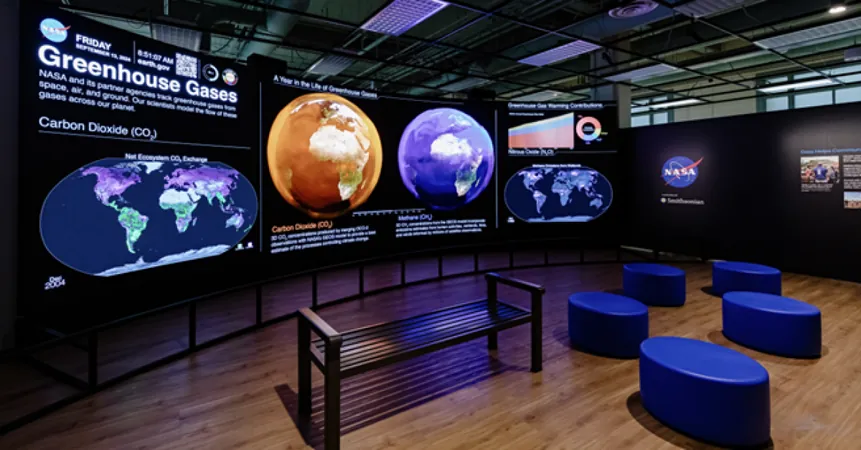
Exciting New NASA Exhibition at Smithsonian Reveals Earth's Dynamic Changes from Space
2024-09-24
Exciting New NASA Exhibition at Smithsonian Reveals Earth's Dynamic Changes from Space
The Smithsonian National Museum of Natural History is set to launch an exciting new exhibition titled “NASA’s Earth Information Center” on Tuesday, October 8. Spanning 2,000 square feet, this groundbreaking exhibition will delve into the dynamic forces that continuously shape our planet, merging scientific data with stunning visuals in an immersive environment.
One of the highlights of the exhibition is a stunning 32-foot-long, 12-foot-high curved video wall that will display breathtaking visualizations of Earth, created from an array of data gathered by satellites and sensors. This innovative presentation aims to illustrate how natural forces, human actions, and climate changes continuously alter the planet's surface. The exhibition is poised to remain open until 2028, allowing many visitors to connect with our planet on a profound level.
Kirk Johnson, the Sant Director of the National Museum of Natural History, expressed, “Partnering with NASA to showcase this dynamic view of Earth deepens our connection with the planet we call home.” The collaboration offers an unprecedented insight into both cosmic and earthly phenomena, merging NASA's insights from outer space with the Smithsonian's on-the-ground research.
NASA Administrator Bill Nelson emphasized, “NASA is a climate agency. By utilizing our extensive fleet of Earth-observing satellites and tools, we provide vital information to assist communities and policymakers in understanding climate change and its implications.” The Earth Information Center (EIC) is designed to make rigorous scientific data easily accessible, allowing users to track real-time information about the environment and climate.
By analyzing the planet from different perspectives—NASA with its expansive satellite views and Smithsonian researchers through field studies—the EIC synthesizes these approaches to present a comprehensive understanding of Earth’s health. The exhibition will offer a live snapshot of environmental data, tracking global temperature, sea-level rise, and greenhouse gas concentrations, crucial information for scientists and the public alike.
What’s especially captivating about the exhibition is the use of the impressive Hyperwall, which not only displays colorful visualizations of data but also airs short videos highlighting ongoing efforts to address environmental challenges. For instance, viewers will witness how scientists from the Smithsonian’s National Zoo use GPS technology and satellite insights to monitor the successful reintroduction of the extinct scimitar-horned oryx in North Africa. Another highlighted project showcases the Jane Goodall Institute’s use of satellite imagery for habitat restoration of chimpanzees.
The exhibition includes interactive elements, offering visitors the chance to explore touchscreen displays and follow the paths of NASA satellites in real-time. A model of the Surface Water and Ocean Topography satellite will also be suspended above the exhibition floor, emphasizing the experimental and educational nature of the exhibit.
The National Museum of Natural History, which first opened its doors in 1910, continues to be one of the most visited natural history museums globally, dedicated to preserving a rich collection of natural specimens and human artifacts. The museum is open daily from 10 a.m. to 5:30 p.m., except on December 25, and admission is free.
This extraordinary exhibition promises to not only educate but also inspire action toward understanding and protecting our changing planet. Don’t miss the opportunity to explore the intricate balance of Earth’s ecosystems and climate—visit the Smithsonian National Museum of Natural History and be part of this transformative experience!





 Brasil (PT)
Brasil (PT)
 Canada (EN)
Canada (EN)
 Chile (ES)
Chile (ES)
 España (ES)
España (ES)
 France (FR)
France (FR)
 Hong Kong (EN)
Hong Kong (EN)
 Italia (IT)
Italia (IT)
 日本 (JA)
日本 (JA)
 Magyarország (HU)
Magyarország (HU)
 Norge (NO)
Norge (NO)
 Polska (PL)
Polska (PL)
 Schweiz (DE)
Schweiz (DE)
 Singapore (EN)
Singapore (EN)
 Sverige (SV)
Sverige (SV)
 Suomi (FI)
Suomi (FI)
 Türkiye (TR)
Türkiye (TR)